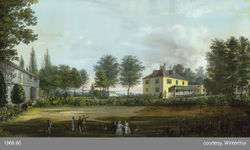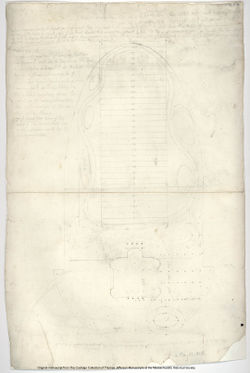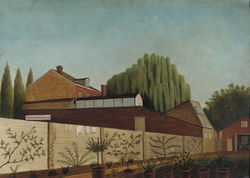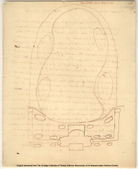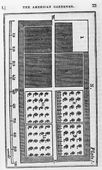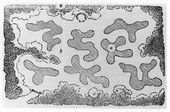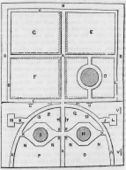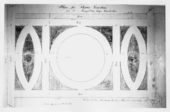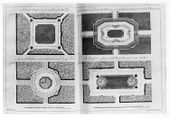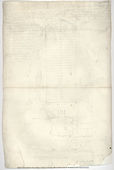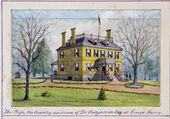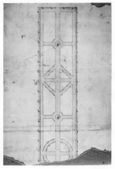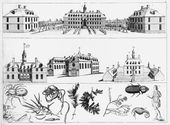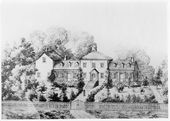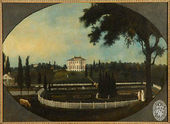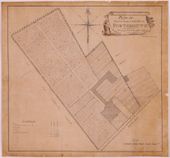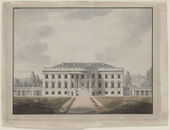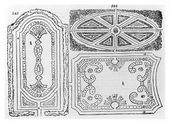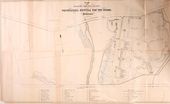Border
(Bordure)
See also: Edging, Espalier, Hedge, Shrubbery
History

Because William Cobbett believed that American readers were unfamiliar with the term border, he included a footnote defining it in the American edition of William Forsyth’s treatise about fruit trees (1802). Nevertheless, earlier 18th-century American accounts and depictions of gardens evince a relative degree of familiarity with what Cobbett described: a ten-foot-wide space, used for growing espaliered fruit trees, situated between a walk and a wall.
In the broadest sense, borders indicated clearly defined spaces in which plant material was grown, a concept that was common in American usage. Less frequently, “border” was a term used to designate edging of beds, such as those made from boards. The term “plate-bandes,” found in 16th-and 17th-century European treatises and referring to the borders used alongside “broidery” parterres, was not commonly used in colonial or federal America.
The use of border to refer to a specific area of the designed landscape devoted to the display of plants and trees changed little during the period between 1600 and 1850. Yet several different, albeit related, meanings of border are found in the American context. A border could refer to the demarcated, outer edge of a discrete and often relatively large garden feature, such as a parterre, lawn, or grass plat [Figs. 1 and 2]. Antoine-Joseph Dezallier d’Argenville (1712) employed this sense of border while counseling readers to enclose parterres to protect the plants within. George Washington, in 1785, requested that several apricot and peach trees be moved to the borders of his grass plats. The Encyclopaedia, or A Dictionary of Arts, Sciences and Miscellaneous Literature (1798) recommended three-to four-foot borders for the outer boundary of a gravel walk surrounding a lawn.
The use of borders as boundaries and enclosures is closely related to their use along the edges of walks, a common practice throughout the 18th and 19th centuries. Lining the edges of walks with borders, which were often three- to four-feet wide, created an elongated space that could accommodate a greater variety of plant material than could beds, which were often limited in diameter for ease of maintenance. In 1807, Thomas Jefferson described his garden at Monticello in a letter and a sketch, with just such an argument for borders, allowing him “to indulge” in a “variety of flowers” [Fig. 3]. The 1832 plans for Mount Auburn Cemetery in Cambridge, Massachusetts, likewise included ten-foot borders filled with shrubs, perennials, and bulb flowers. George William Johnson, writing in 1847, cautioned against overly narrow borders that would convey a sense of “meanness” to the scene as opposed to the “grandeur” of an ample border.
Borders could frame walks, avenues, or drives (as at Rosewell, on the York River, Virginia [Fig. 4]; the Lilacs, the residence of Thomas Kidder in Medford, Massachusetts; and Mount Auburn Cemetery), or they could skirt walls, espaliers, shrubberies, or other related structures (as at The Woodlands and Peale’s Museum in Philadelphia, Pennsylvania [Fig. 5]; and the Elias Hasket Derby House in Salem, Massachusetts [Fig. 6]). Johnson, in fact, pointed to these uses when defining border in his 1847 dictionary. There he noted that, in addition to offering extensive space for the display of plants, framing borders also acted as screening devices, to cloak walls, for example.
The notion of a border as a bank raised around a garden, as described by Samuel Johnson (1755) and echoed by Noah Webster (1828), seems to have been little-documented in American garden design. No descriptions or depictions of this practice have yet been identified.
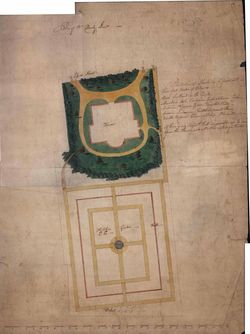
Plant material within borders varied widely. Fruit trees, dwarf trees, specimen trees, shrubs, and perennial and annual flowers all appear in descriptions of borders. Borders could also house vegetables, especially when placed within the confines of a kitchen garden. As discrete units set within a larger garden complex, borders were useful for separating different kinds of plant material, as at Lemon Hill in Philadelphia, where borders of pinks and other flowers enclosed squares that were planted with vegetables and fruits.
A general shift, however, can be detected in the arrangement of plants within flower borders, from the “judicious” mixing that allowed individual specimens to be highlighted in the 17th, 18th, and early 19th centuries to the use of masses of plants to create broad swatches of color by the mid-19th century. William Hamilton’s border at The Woodlands corresponds to the latter type in his desire to display a great variety of plants while maintaining “distinctions of the sorts.” Jefferson, less interested in curious exotics, used his border to grow “handsome” or “fragrant” plants, and his 1811 letter to Bernard M’Mahon indicates that he had hoped to grow plants recognized then as “florist’s flowers,” plants appreciated for the unique beauty of their blossoms. By contrast, Jane Loudon (1845) and Joseph Breck (1851) both advocated massing plants and choosing plants for a constant display of color rather than for the flowers’ unique qualities. Throughout this shift, the notion of arranging plants in graduated rows from lowest to highest appears to have remained relatively unchanged. See, for example, the recommendations of English treatise writer Richard Bradley (1719–20) and Jane Loudon (1845).
—Anne L. Helmreich
Texts
Usage
- Washington, George, February 9, 12, and 18, and March 12 and 14, 1785, describing Mount Vernon, plantation of George Washington, Fairfax County, VA (Jackson and Twohig, eds., 1978: 4:87, 89, 92; 101–2)[1]
- “Transplanted an English Walnut tree. . . but from their size and age I have little expectation of their living. Also moved the Apricots & Peach Trees which stood in the borders of the grass plats which from the same causes little expectation is entertained of their living. . .
- “Planted Eight young Pair Trees sent me by Doctr. Craik in the following places—viz.
- “2 Orange Burgamots in the No. Garden, under the back wall—3d. tree from the Green House at each end of it.
- “1 Burgamot at the Corner of the border in the South Garden just below the necessary.
- “2 St. Germains, one in each border (middle thereof) of the upper Squares by the Asparagas Bed & Artichoake Ditto upper bordr.
- “3 Brown Beuries in the west square in the Second flat—viz. 1 on the border (middle thereof) next the Fall or slope—the other two on the border above the walk next the old Stone Wall. . .
- “Planted border of Ivy under the No. side of the So. Garden wall. . .
- “Laid the borders of the gravel walk to the No. Necessary—from the circle in the Court yard. . .
- “Planted the 9 young peach Trees which I brought from Mr. Cockburns in the No. Garden—viz.—4 on the South border of the second walk (two on each side of the middle walk)—2 in the border of the Walk leading from the Espalier hedge towards the other cross walk and 3 under the South wall of the Garden; that is two on the right as we enter the gate & one on the left. The other Peach tree to answer it on that side & the two on the West Walk, parrallel to the Walnut trees were taken from the nursery in the Garden.”
- Cutler, Manasseh, July 14, 1787, describing Gray’s Tavern, Philadelphia, PA (1987: 1:275)[2]
- “In the borders were arranged every kind of flower, one would think, that nature had ever produced, and with the utmost display of fancy, as well as variety.”
- Hamilton, William, 1789, in a letter to his secretary, Benjamin Hays Smith, discussing plans for The Woodlands, seat of William Hamilton, near Philadelphia, PA (quoted in Madsen 1988: A4, A5)[3]
- “I would have Hilton dig a piece of the Border on the East side of the House somewhere about the front of the paper Birch or double Peach. It should be french dug & three or four Inches thickness of fine mould put on the surface & they [exotic bulbous roots] should be planted at six or eight Inches from each other & about 5 or 6 inches deep taking care to preserve the distinctions of the sorts which can be easily done as they were all laid in ranges by themselves. . .
- “[2 May] I would have you mark all the polianthos snow drops in the Bord’rs of the Ice H. Hill walk. . .
- “[1 June] I meant to have made a small 3 feet wide Border in front of the necessary skreen of cedars & Lombardy populars & to have planted some of these Runners at the foot of them to run up and hide the dead cedars. What was not used of them I meant to have sown in such a manner as to have run over the Espalier as soon as the Border along it was cleand. If the Border is done you can have them sowd in such a manner as to produce the greatest variety.”
- Constantia [Judith Sargent Murray], June 24, 1790, “Description of Gray’s Gardens, Pennsylvania” (Massachusetts Magazine 3: 415)[4]
- “Now, side long bends the path; then, pursues its winding way; now, in a straight line; then, in a pleasing labyrinth is lost, until, in every possible direction, it breaketh upon us, amid thick groves of pines, walnuts, chestnuts, mulberries, &c. &c. we seem to ramble, while at the same time, we are surprized [sic] by borders of the richest, and most highly cultivated flowers, in the greatest variety, which even from a royal parterre we might be led to expect. . .
- “In the flower borders, the silver pine, the turin poplar, bay tree, and a variety of ever greens, are judiciously interspersed.”
- Beebe, Lewis, 1800, describing a Mr. Pratt’s garden [undetermined location] (quoted in Martin 1991: 113)[5]
- “An ally of 13 feet wide runs the length of the garden thro’ the centre—. Two others of 10 feet wide equally distant run parallel with the main alley. These are intersected at right angles, by 4 other alleys of 8 feet wide—Another alley of 5 feet wide goes around the whole garden, leaving a border of 3 feet wide next to the pales. This lays the garden into 20 squares, each square has a border around it of 3 feet wide. The border of the main alley, is ornamented with flowers of every description. Likewise the border of every square, is decorated with pinks and a thousand other flowers, which it [is] impossible for me to describe. The remaining part of each square, within the border, is planted with beans, pease, cabbage, onions, Beets, carrots, Parsnips, Lettuce, Radishes, Strawberries, cucumbers, Potatoes, and many other articles. . . Within the pales, on the out border, one planted, Quince, snowball, Laylock, and various other small trees, producing the most beautiful flowers.”
- Pintard, John, 1801, describing New Orleans, LA (quoted in Sterling 1951: 227–28)[6]
- “The Governours [sic] House fronts the river—is a large wooden building formerly the Treasury. . . A very fine garden belongs to this house—at least as to Trees—Orange & etc but no great taste as yet prevails in the design of any garden—I have seen all that have any pretensions that way, being disposed in the old still formal style—the border and circles kept up with strips of board wh[ich] have a very mean effect.”
- Jefferson, Thomas, June 7, 1807, describing Monticello, plantation of Thomas Jefferson, Charlottesville, VA (quoted in Betts and Perkins 1986: 36)[7]
- “I find that the limited number of our flower beds will too much restrain the variety of flowers in which we might wish to indulge, and therefore I have resumed an idea . . of a winding walk surrounding the lawn. . . with a narrow border of flowers on each side.”
- Jefferson, Thomas, April 8, 1811, in a letter to Bernard M’Mahon, describing Monticello, plantation of Thomas Jefferson, Charlottesville, VA (1944: 455)[8]
- “I have an extensive flower border, in which I am fond of placing handsome plants or fragrant. those of mere curiosity I do not aim at, having too many other cares to bestow more than a moderate attention to them. in this I have placed the seeds you were so kind as to send me last. in it I have also growing the fine tulips, hyacinths, tuberoses & Amaryllis you formerly sent me. my wants there are Anemones, Auriculas, Ranunculus, Crown Imperials & Carnations.”
- Forman, Martha Ogle, 1824 and 1827, describing Rose Hill, home of Martha Ogle Forman, Baltimore County, MD (1976: 176, 232)[9]
- “[6 March 1824] I had the two borders to right and left of the Garden gate planted with shrubbery and several planted on the approach to the garden. . .
- “[31 March 1827] A very pleasant day, dividing the crocuses on the left border of the garden.”
- Dearborn, H. A. S., September 30, 1831, describing Mount Auburn Cemetery, Cambridge, MA (quoted in Ward 1831: 47, 80)[10]
- “As the tract which has been solemnly consecrated, by religious ceremonies, as a burial-place forever, is so abundantly covered with forest trees, many of which are more than sixty years old, it only requires the avenues to be formed, the borders, for some ten feet in width, planted with shrubs, bulbous and perennial flowers . . . to put the grounds in a sufficiently complete state for the uses designed, and to render them at once beautiful and interesting. . .
- “The upper Garden Pond has been excavated, to a sufficient depth to afford a constant sheet of water, with a fall at the outlet of three feet, and being embanked, avenues with a border of six feet, for shrubs and flowers, have been made all round it.”
- Hovey, C. M. (Charles Mason), October 1839, “Some Remarks upon several Gardens and Nurseries in Providence, Burlington, (N.J.) and Baltimore,” describing the residence of Horace Binney, Burlington, NJ (Magazine of Horticulture 5: 363)[11]
- “The flower garden is nearly a square, and is laid out with one main circular walk, running round the whole, and a border for flowers on each side; the centre forming a lawn scattered over with several large fruit trees.”
- Hovey, C. M. (Charles Mason), November 1839, “Notices of Gardens and Horticulture, in Salem, Mass.,” describing Elias Hasket Derby House, Salem, MA (Magazine of Horticulture 5: 410–11)[12]
- “The garden lies to the south of the mansion, and is, we should judge, nearly a square. It is laid out with straight walks, running at right angles, with flower borders on each side of the alleys, and the squares occupied by fruit trees.”
- Lyell, Sir Charles, 1846, describing Natchez, MS (1849: 2:153)[13]
- “Many of the country-houses in the neighborhood are elegant, and some of the gardens belonging to them laid out in the English, others in the French style. In the latter are seen terraces, with statues and cut evergreens, straight walks with borders of flowers, terminated by views into the wild forest, the charms of both being heightened by contrast.”
- Kirkbride, Thomas S., April 1848, describing the pleasure grounds and farm of the Pennsylvania Hospital for the Insane, Philadelphia, PA (American Journal of Insanity 4: 349)[14]
- “The semi-circular yard, on the western side of the main building is surrounded by flower borders, contains the circular pleasure Rail-road, and is used at different hours, by patients of both sexes.”
- Downing, Andrew Jackson, 1849, describing Hyde Park, seat of David Hosack, on the Hudson River, NY (1849: 443)[15]
- “Those who have seen the shrubbery at Hyde Park, the residence of the late Dr. Hosack, which borders the walk leading from the mansion to the hot-houses, will be able to recall a fine example of this mode of mingling woody and herbaceous plants. The belts or borders occupied by the shrubbery and flower-garden there, are perhaps from 25 to 35 feet in width, completely filled with a collection of shrubs and herbaceous plants; the smallest of the latter being quite near the walk; these succeeded by taller species receding from the front of the border, then follow shrubs of moderate size, advancing in height until the background of the whole is a rich mass of tall shrubs and trees of moderate size. The effect of this belt on so large a scale, in high keeping, is remarkably striking and elegant.”
- Londoniensis [pseud.], October 1850, “Notes and Recollections of a Visit to the Nurseries of Messrs. Hovey & Co., Cambridge” (Magazine of Horticulture 16: 445)[16]
- “In the first place, the nursery is laid out in angular divisions, diverging from a common centre. These divisions are separated from each other by wide walks and avenues, on each side of which is a border some eight or nine feet wide. These borders are planted with specimen trees, inside of which are the quarters for the nursery stock.”
Citations
- Dezallier d’Argenville, Antoine-Joseph, 1712, The Theory and Practice of Gardening (1712: 35–36)[17]
- “BORDERS serve to bound and inclose Parterres, that they be not hurt by walking in them, and become very ornamental by the Yews, Shrubs, and Flowers, that are raised in them. Four Foot is usually allowed for the Breadth of the lesser, and five or six Foot for that of the larger Borders; and they are always laid with a sharp Rising in the Middle, being no way agreeable to the Eye when they are flat.
- “OF Borders there are four Sorts: The most common are those that are continued about Parterres without any Interruption, and are wrought with a sharp Rising in the Middle, like an Ass’s Back, and set out with Flowers, Shrubs, and Yews.
- “THE second Kind is a Border cut into Compartiment, at convenient Distances, by small Passages, and is likewise adorned with Flowers and Shrubs, being raised in the Middle as before-mentioned.
- “THE third Sort of Borders, are all eaven [sic] and flat, without Flowers, having only a Verge of Grass in the Middle, edged by two small Paths raked smooth and sanded. These are sometimes garnished with Yews and flowering Shrubs, or with Vases and Flower-Pots set regularly along the Middle of the Verge of Grass.
- “THE fourth Sort of Borders are quite plain, and only sanded, as in the Parterres of Orangery, and are filled with Cases ranged regularly along the Borders, which, on the Sides next the Walks, are edged with Box; and on the other, with the Verges and Grass-work of the Parterre. Sometimes Yews are planted between each Case, which makes the Borders look richer, and the Parterres much handsomer, during the Winter.
- “BORDERS are made strait, circular, or in Cants, and are turned into Volutes, Scrolls, Knots, and other Compartiments.
- “FLORISTS likewise make use of Borders either detached or along Walls, which they encompass with Border-boards painted green, that are exceeding neat, and in these they raise their finest and choicest Flowers; but this is not to be looked for in large Parterres, where ‘tis sufficient to have them stocked with Flowers in their several Seasons as they succeed one another, that nothing appear bare and naked.”
- Bradley, Richard, 1719–20, New Improvements of Planting and Gardening (1719–20 1:63–64; 1720: 2:27)[18]
- [vol. 1] “. . . in the Planting a Border or Bed of Flowers, we may judiciously mix the several Sorts, so as to have not only some of them in Blossom every Month of the Year, but that they may be so disposed as to appear gradually one above the other, and add Beauty to each other by their Variety of Colours. . .
- [vol. 2] “I must confess, was I to make an Orchard to please my self, I would first divide the Ground into parcels, allowing handsome Walks between them, which should some of them be fenced on the Sides with Espaliers of Fruit, others left open with Borders only on their Sides, adorn’d with Rows of Standard-Apples.”
- Chambers, Ephraim, 1741–43, Cyclopaedia (2:n.p.)[19]
- “PLAT-BAND, in gardening, a border, or bed of flowers, along a wall, or the side of a parterre; frequently edged with box, &c. See PARTERRE, EDGING, &c.”
- Johnson, Samuel, 1755, A Dictionary of the English Language (1:n.p.)[20]
- “BORDER. . . n.s. [bord, Germ. bord, Fr.] . . .
- “4. A bank raised round a garden, and set with flowers; a narrow rank of herbs or flowers.”
- Anonymous, 1798, Encyclopaedia (7:542)[21]
- “For the convenience of walking in damp weather, this lawn should be surrounded with a gravel-walk, on the outside of which should be borders three or four feet wide for flowers.”
- Cobbett, William, 1802, A Treatise on the Culture and Management of Fruit Trees (quoted in Forsyth 1802: 4)[22]
- “*The American reader will not readily know what is here meant by the word Borders; it is therefore necessary to observe to him, that the finer kinds of fruit trees are, in England, trained against walls, and that there is generally a walk goes round the garden, running in a parallel line with the wall, at the distance of about ten feet from it; the space between the walk and the wall, is called the Border; so that, when the author speaks of the soil and tillage of the Borders, he is merely speaking of the soil and tillage of the land, in which the several trees are, or may be, planted.”
- Forsyth, William, 1802, A Treatise on the Culture and Management of Fruit Trees (1802: 146, 148)[22]
- “The garden should be surrounded with a border, or slip, from forty to sixty feet wide or more, if the ground can be spared; and this again inclosed with an oak paling from six to eight feet high, with a cheval-de-frise at top. . .
- “The borders under the walls, in the inside, should be from ten to twenty feet wide, according to the size of the garden, to give full liberty to the roots of the trees to spread.”
- M’Mahon, Bernard, 1806, The American Gardener’s Calendar (1806: 16)[23]
- “Espaliers are hedges of fruit-trees, which are trained up regularly to a lattice or trellis of wood work, and are commonly arranged in a single row in the borders, round the boundaries of the principal divisions of the kitchen-garden; there, serving a double or treble purpose, both profitable, useful, and ornamental. They produce large fine fruit plentifully, without taking up much room, and being in a close range, hedge-like; they in some degree shelter the esculent crops in the quarters; and having borders immediately under them each side, afford different aspects for different plants.”
- Gregory, G. (George), 1816, A New and Complete Dictionary of Arts and Sciences (2:n.p.)[24]
- “GARDENING. . .
- “A wide border next the south wall [in a garden], as was said, is best for the trees; and moreover for the many uses that may be made of it for the smaller early, or late tender esculents, and a few early cauliflowers. For the sake of a pleasant warm walk in spring, to have the south border narrow may be desirable; but on no account let it be less than six feet. . .
- “The beds for tulips, hyacinths, anemonies, ranunculuses, &c. may be three and a half or four feet wide, and those for single flowers the same, or only two and a half feet wide in the borders, which was the most usual breadth in the old flower gardens.”
- Abercrombie, John, with James Mean, 1817, Abercrombie’s Practical Gardener (1817: 4)[25]
- “The margin [of the kitchen garden], all round, allot for borders, from eight to twelve feet wide, and extended under the walks by prepared soil. . . As the borders and beds are marked out, trench them two spits deep, if good soil reach so low. Next to the borders, leave space for a walk entirely round the garden, from four to six feet wide. Some persons also choose to have a border on the inward side of the walk, for the cultivation of espaliers, and esculents of dwarf growth.”
- Loudon, J. C. (John Claudius), 1826, An Encyclopaedia of Gardening (1826: 1020)[26]
- “7258. Narrow terraces. . . Where the breadth is more than is requisite for walks, the borders may be kept in turf with groups or marginal strips of flowers and low shrubs.”
- Webster, Noah, 1828, An American Dictionary of the English Language (1828: 1:n.p.)[27]
- “BORD'ER, n. [Fr. bord; Arm. id; Sp. bordo; Port. borda; It. bordo. See Board.]
- “the exterior part of a garden, and hence a bank raised at the side of a garden, for the cultivation of flowers, and a row of plants.”
- Bridgeman, Thomas, 1832, The Young Gardener’s Assistant (1832: 1–2)[28]
- “. . . some important matters essential to the good management of a Kitchen Garden. . .
- “To this end, he [the gardener] may form a border round the whole garden, from five to ten feet wide, according to the size of the piece of land; next to this border, a walk may be made from three to six feet wide; the centre part of the garden may be divided into squares, on the sides of which a border may be laid out three or four feet wide, in which the various flowering plants may be raised, unless a separate flower garden is intended. The centre beds, may be planted with all the various kinds of vegetables as well as Gooseberries, Currants, Raspberries, Strawberries, &c. The outside borders facing the East, South and West, will be useful for raising the earliest fruits and vegetables, and the North border being shady and cool, will serve for raising, and pricking out such young plants, slips and cuttings as require to be screened from the intense heat of the sun.”
- Hovey, C. M. (Charles Mason), March 1840, “Some Remarks on the Formation of the Margins of Flower Beds on Grass Plots or Lawns” (Magazine of Horticulture 6: 84–85)[29]
- “We are glad to learn that our observations have been the means of drawing attention to the subject, and that they have, in some instances, induced amateurs to adopt the style of planting small grass plots, and forming upon them circular, or other shaped beds, for flowers. . . the method is, generally, to be much preferred to the old, and almost universally followed system, of forming gravelled walks, with board, grass, or box edgings, and dug borders.”
- Buist, Robert, 1841, The American Flower Garden Directory (1841: 32)[30]
- “Grass verges for walks and borders, although frequently used, are, by no means, desirable, except where variety is required; they are the most laborious to keep in order, and at best are inelegant, and the only object in their favour is, there being everywhere accessible.”
- Loudon, Jane, 1845, Gardening for Ladies (1845: 131–32)[31]
- “BORDER.—A border differs from a bed in having a walk only on one side; and an ornamental border, in which flowers or shrubs, or both, are grown, ought to have the plants so arranged in regard to height and distance, as to have them seen to the greatest advantage from the walk. For this purpose the lowest-growing plants should be placed in front, and the highest kinds behind them, and the distance between the different plants should be proportioned to their breadth, not to their height. . . With regard to the mode of arranging herbaceous plants in borders with reference to the colour of their flowers and time of flowering, the object ought to be to have an equal number of plants in flower in each of the floral months; and among the plants of each month to have as nearly as possible an equal number of each of the principal colours. This is the beau idéal that the cultivator should keep in view; but it is not easy to carry it out into practice without the assistance of a reserve garden, and a number of plants in pots, that can be brought out when in flower on the shortest notice. . .
- “BORDER FLOWERS.—Herbaceous plants of hardy constitution; showy in appearance, and of easy culture, and therefore well adapted for ornamenting the borders which accompany walks in gardens.”
- Johnson, George William, 1847, A Dictionary of Modern Gardening (1847: 96, 165)[32]
- “BORDER, is a name applied to that narrow division of the garden which usually accompanies each side of a walk in the pleasure-grounds, and to the narrow bed which is close to the garden wall on one side, and abuts on a walk on the other. The walls being mostly occupied by fruit trees, the latter may be considered as the fruit-borders, and the first-named as the flower-borders.
- “1. Fruit-borders.—Next to the wall should be a path three feet wide, for the convenience of pruning and gathering. Next to this path should be the border, eight or nine feet wide; and then the broad walk, which should always encompass the main compartments of the kitchen garden. . .
- “2. Flower borders.—These, like the preceding, and indeed like every other part of the garden not devoted to aquatic and marsh plants, should be well drained. In plotting them it must also be remembered, that if narrow, no art will impart to them an aspect of boldness and grandeur. Indeed narrowness of surface is inseparably connected with an impression that the grounds are of limited extent, and no disposal of the plants will remove the littleness thus suggested. If the pleasure grounds are small, narrow borders are permissible, but even then the broader they are the less is the appearance of meanness. Neatness must be the presiding deity over flower borders, and no application of the hoe and rake, no removal of decayed leaves, no tying up of struggling members, can be too unremitting. . .
- “CONSERVATORY. This structure is a greenhouse communicating with the residence, having borders and beds in which to grow its tenant plants.”
- Downing, Andrew Jackson, February 1849, “Design for a Suburban Garden” (Horticulturist 3: 380)[33]
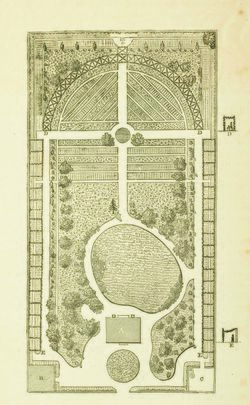
- “At the end of this wall, we come to the semicircular Italian arbor, D. . .
- “Beyond this arbor, and at the termination of the central walk, is a vase, rustic basket, or other ornamental object, e. The semi-circle, embraced within the arbor, is a space laid with regular beds. This is devoted to kitchen garden crops, as is also all the outside border behind it. The other borders (under the vines, E,) may be cropped with strawberries, or lettuces, and other small culinary vevetables [sic], with a narrow grouping of flowers near the walk or not, as the taste of the owner may dictate. The small trees, planted in rows on the border, between the walk, E, and the ornamental lawn, are dwarf pears and apples.” [Fig. 7]
- Breck, Joseph, 1851, The Flower-Garden (1851: 19–20, 39)[34]
- “. . . a walk should be carried round the outward boundary [of a flower garden], leaving a border to surround the whole ground. This outward border will be the most appropriate place for choice flowering shrubs, and tall herbaceous biennial and perennial plants. If the border be a wide one, groups of ornamental trees, of low growth, may be planted in the background, especially on the northern and western quarters, which will greatly protect the plants from cold winds, particularly if they be evergreens. . .
- “Masses of annuals may be so arranged as to make a grand display in the common flower-garden. We have seen the walks of an extensive flower-garden deeply edged with a wide border of crimson and scarlet Portulaccas; and, throughout the whole garden, all the annuals, and other plants, in fact, were planted in masses. We have never seen a better managed garden than this one. It contained about an acre of ground. Not more than twenty or thirty kinds of annuals were cultivated in the garden, and of this class of plants more than one half of the ground was filled. They consisted of every variety of Double Balsams, German Asters, Drummond Phlox, Coreopsis, Amaranths, Verbenas, Portulaccas, Double China Pinks, Petunias, Mignionette, Cockscombs, Gilliflowers, &c.”
Images
Inscribed
Unknown, Derby Garden, [circa 1795–1799], Samuel McIntire Papers, MSS 264, flat file, plan 107. Courtesy of Phillips Library, Peabody Essex Museum, Rowley, MA. “Plantation of Shrubs to be faced with a three foot Border of Flowers.”
Thomas Jefferson, Sketch of the garden and flower beds at Monticello, June 7, 1807. “Oval beds of flowering shrubs” [written on verso].
J. C. Loudon, Moveable edgings: basket edging and the earthenware border, in An Encyclopaedia of Gardening (1826), 296, figs. 219 and 220.
J. C. Loudon, Plan of a flower garden with irregular borders (c), in An Encyclopaedia of Gardening (1826), 791, fig. 540.
Richard Dolben, “Plan for Flower Garden,” 1847.
Anonymous, “Plan of a Suburban Garden,” in A. J. Downing, ed., Horticulturist 3, no. 8 (February 1849): pl. opp. 353. “The “borders” are “(under the vines, E,).” Inscription on page 380.
Associated
Thomas Jefferson, Plan of serpentine walk and flower beds at Monticello, May 23, 1808.
Anonymous, “English Flower-Garden,” in A. J. Downing, A Treatise on the Theory and Practice of Landscape Gardening (1849): 434, fig. 78.
Frances Palmer, Ground plot of a cottage, in William H. Ranlett, The Architect (1849), vol 1, pl. 23.
Frances Palmer, “Ground Plot of 4-1/4 Acres,” in William H. Ranlett, The Architect (1851), vol. 2, pl. 6. "The lawn is on the north of the house. . . with borders on the north side."
Attributed
Charles Fraser, Wigton on Saint James, Goose Creek: The Seat of James Fraser, Esq., c. 1800.
Anonymous, The Beehive, 1800-1820.
Francis Guy, Bolton, view from the South, c. 1805.
Charles Willson Peale, View of the garden at Belfield, 1816.
Benjamin Henry Latrobe, Elevation of the South front of the President’s house, copied from the design as proposed to be altered in 1807, January 1817.
Harriet De (?), The Duck Pond, c. 1820.
J. C. Loudon, Plans of the surfaces of flower gardens, in An Encyclopaedia of Gardening (1826), p. 793, figs. 543 and 544.
Anonymous, Map of Mr. Andrew Parmentier’s Horticultural & Botanical Garden, at Brooklyn, Long Island, Two Miles From the City of New York, c. 1828. On the right of this plan, alleys are straight walk-ways that have been defined by plantings of several kinds of fruit trees (“L” through “P”).
Thomas S. Sinclair, “Plan of the Pleasure Grounds and Farm of the Pennsylvania Hospital for the Insane at Philadelphia,” in Thomas S. Kirkbride, American Journal of Insanity 4, no. 4 (April 1848): pl. opp. 280.
Notes
- ↑ George Washington, The Diaries of George Washington, ed. Donald Jackson and Dorothy Twohig, 6 vols. (Charlottesville: University Press of Virginia, 1978), view on Zotero.
- ↑ William Parker Cutler, Life, Journals, and Correspondence of Rev. Manasseh Cutler, LL.D. (Athens, OH: Ohio University Press, 1987), view on Zotero.
- ↑ Karen Madsen, “William Hamilton’s Woodlands,” (paper presented for seminar in American Landscape, 1790–1900, instructed by E. McPeck, Radcliffe Institute for Advanced Study, Harvard University, 1988), view on Zotero.
- ↑ Constantia [Judith Sargent Murray], “Description of Gray’s Gardens, Pennsylvania,” Massachusetts Magazine, or, Monthly Museum of Knowledge and Rational Entertainment 7, no. 3 (July 1791): 413–17, view on Zotero.
- ↑ Peter Martin, The Pleasure Gardens of Virginia: From Jamestown to Jefferson (Princeton, NJ: Princeton University Press, 1991), view on Zotero.
- ↑ David Lee Sterling, ed., “New Orleans, 1801: An Account by John Pintard,” Louisiana Historical Quarterly, 34 (1951), 217–33, view on Zotero.
- ↑ Edwin M. Betts and Hazlehurst Bolton Perkins, Thomas Jefferson’s Flower Garden at Monticello (Charlottesville: Thomas Jefferson Foundation, University of Virginia, 1986), view on Zotero.
- ↑ Thomas Jefferson, The Garden Book, ed. Edwin M. Betts (Philadelphia: American Philosophical Society, 1944), view on Zotero.
- ↑ Martha Ogle Forman, Plantation Life at Rose Hill: The Diaries of Martha Ogle Forman, 1814–1845 (Wilmington, DE: Historical Society of Delaware, 1976), view on Zotero.
- ↑ Malthus A. Ward, An Address Pronounced Before the Massachusetts Horticultural Society (Boston: J. T. & E. Buckingham, 1831), view on Zotero.
- ↑ C. M. Hovey, “Some Remarks upon Several Gardens and Nurseries, in Providence, Burlington, (N.J.) and Balitmore,” Magazine of Horticulture, Botany, and All Useful Discoveries and Improvements in Rural Affairs 5, no. 10 (October 1839): 361–76, view on Zotero.
- ↑ Charles Mason Hovey, “Notices of Gardens and Horticulture, in Salem, Mass.,” Magazine of Horticulture, Botany, and All Useful Discoveries and Improvements in Rural Affairs 5, no. 11 (November 1839): 401–16, view on Zotero.
- ↑ Sir Charles Lyell, A Second Visit to the United States of North America, 2 vols. (New York: Harper, 1849), view on Zotero.
- ↑ Thomas S. Kirkbride, “Description of the Pleasure Grounds and Farm of the Pennsylvania Hospital for the Insane, with Remarks,” American Journal of Insanity 4, no. 4 (April 1848): 347–54, view on Zotero.
- ↑ A. J. Downing, A Treatise on the Theory and Practice of Landscape Gardening, Adapted to North America 4th ed. (New York: George P. Putnam, 1849), view on Zotero.
- ↑ Londoniensis, “Notes and Recollections of a Visit to the Nurseries of Messrs. Hovey & Co., Cambridge,” Magazine of Horticulture, Botany, and All Useful Discoveries and Improvements in Rural Affairs 16, no. 10 (October 1850): 442–47, view on Zotero.
- ↑ A.-J. (Antoine Joseph) Dézallier d’Argenville, The Theory and Practice of Gardening; Wherein Is Fully Handled All That Relates to Fine Gardens, . . . Containing Divers Plans, and General Dispositions of Gardens. . . , trans. John James (London: Geo. James, 1712), view on Zotero.
- ↑ Richard Bradley, New Improvements of Planting and Gardening, Both Philosophical and Practical; Explaining the Motion of the Sapp and Generation of Plants. With Other Discoveries Never before Made in Publick, for the Improvement of Forest-Trees, Flower-Gardens or Parterres; with a New Invention Where by More Designs of Garden Platts May Be Made in an Hour, than Can Be Found in All the Books Now Extant. Likewise Several Rare Secrets for the Improvement of Fruit-Trees, Kitchen-Gardens, and Green-House Plants, 3rd ed., 2 vols. (London: W. Mears, 1719–20), view on Zotero.
- ↑ Ephraim Chambers, Cyclopaedia, or An Universal Dictionary of Arts and Sciences. . . , 5th ed., 2 vols. (London: D. Midwinter et al., 1741–43), view on Zotero.
- ↑ Samuel Johnson, A Dictionary of the English Language: In Which the Words Are Deduced from the Originals and Illustrated in the Different Significations by Examples from the Best Writers, 2 vols. (London: W. Strahan for J. and P. Knapton, 1755), view on Zotero.
- ↑ Anonymous, Encyclopaedia, or A Dictionary of Arts, Sciences, and Miscellaneous Literature, 18 vols. (Philadelphia: Thomas Dobson, 1798), view on Zotero.
- ↑ 22.0 22.1 William Forsyth, A Treatise on the Culture and Management of Fruit Trees (Philadelphia: J. Morgan, 1802), view on Zotero.
- ↑ Bernard M’Mahon, The American Gardener’s Calendar: Adapted to the Climates and Seasons of the United States. Containing a Complete Account of All the Work Necessary to Be Done. . . for Every Month of the Year. . . (Philadelphia: Printed by B. Graves for the author, 1806), view on Zotero.
- ↑ George Gregory, A New and Complete Dictionary of Arts and Sciences, 1st American ed., 3 vols. (Philadelphia: Isaac Peirce, 1816), view on Zotero.
- ↑ John Abercrombie, Abercrombie’s Practical Gardener Or, Improved System of Modern Horticulture (London: T. Cadell and W. Davies, 1817), view on Zotero.
- ↑ J. C. (John Claudius) Loudon, An Encyclopaedia of Gardening; Comprising the Theory and Practice of Horticulture, Floriculture, Arboriculture, and Landscape-Gardening, 4th ed. (London: Longman et al., 1826), view on Zotero.
- ↑ Noah Webster, An American Dictionary of the English Language, 2 vols. (New York: S. Converse, 1828), view on Zotero.
- ↑ Thomas Bridgeman, The Young Gardener’s Assistant, 3rd ed. (New York: Geo. Robertson, 1832), view on Zotero.
- ↑ C. M. Hovey, “Some Remarks on the Formation of the Margins of Flower Beds on Grass Plots or Lawns,” Magazine of Horticulture, Botany, and All Useful Discoveries and Improvements in Rural Affairs 6, no. 3 (March 1840): 84–86, view on Zotero.
- ↑ Robert Buist, The American Flower Garden Directory, 2nd ed. (Philadelphia: Carey and Hart, 1841), view on Zotero.
- ↑ Jane Loudon, Gardening for Ladies; and Companion to the Flower-Garden, ed. A. J. Downing (New York: Wiley & Putnam, 1845), view on Zotero.
- ↑ George William Johnson, A Dictionary of Modern Gardening, ed. David Landreth (Philadelphia: Lea and Blanchard, 1847), view on Zotero.
- ↑ A. J. Downing, “Design for a Suburban Garden,” Horticulturist and Journal of Rural Art and Rural Taste 3, no. 8 (February 1849): 380, view on Zotero.
- ↑ Joseph Breck, The Flower-Garden, or Breck’s Book of Flowers (Boston: John P. Jewett, 1851), view on Zotero.
